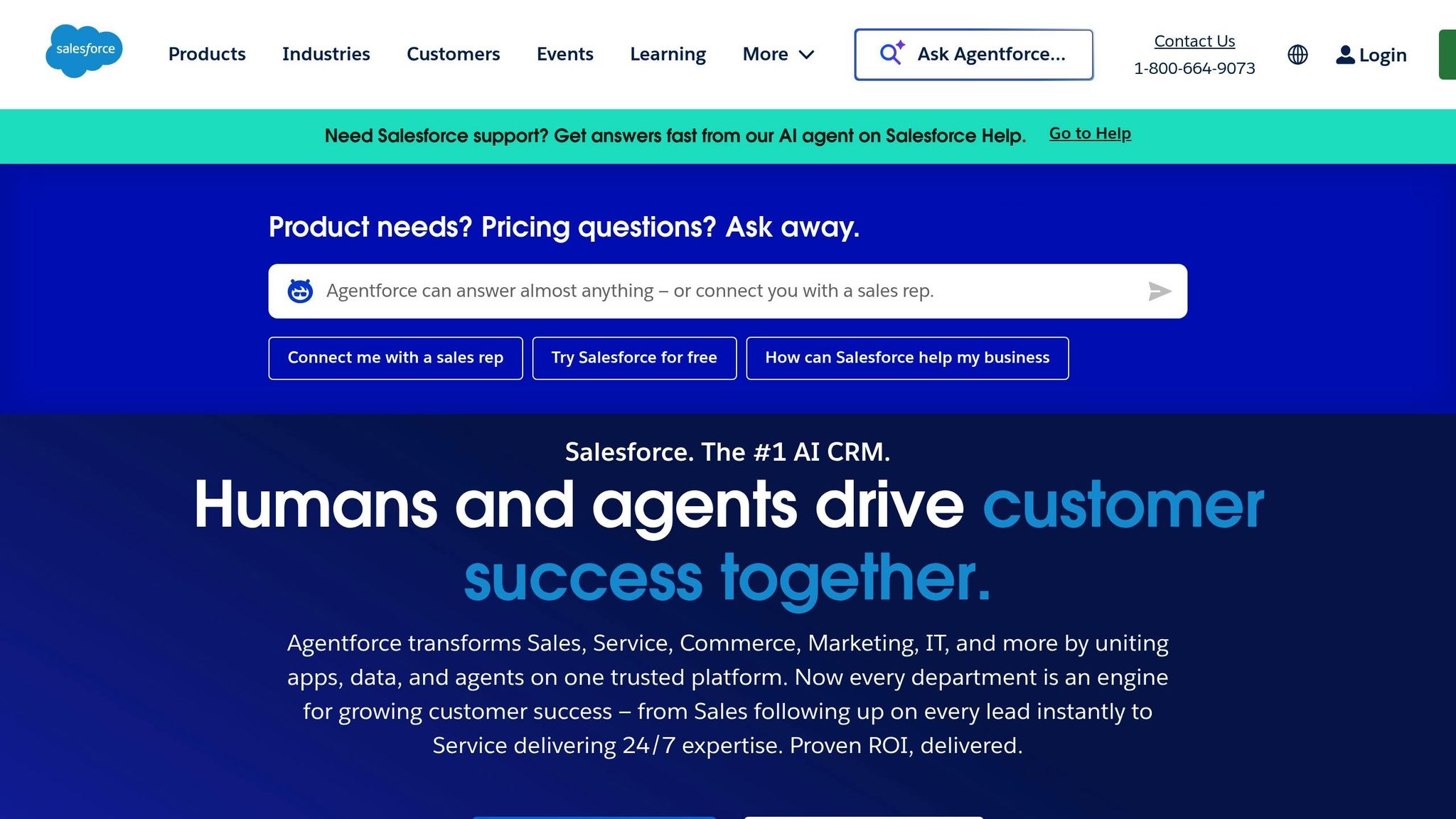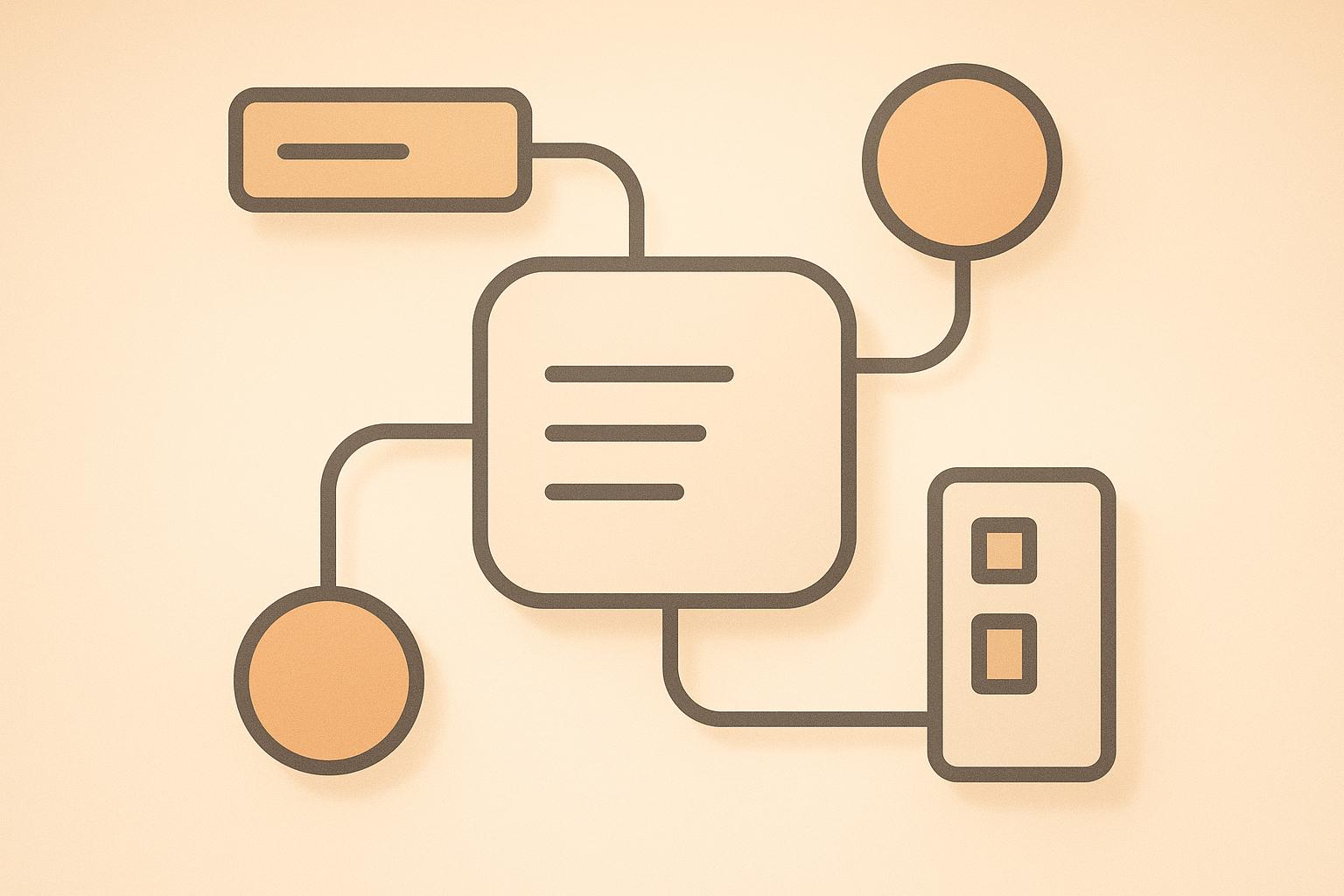
.avif)
Julien Gadea
Julien Gadea specializes in AI prospecting solutions for business growth. Empowering businesses to connect with their audience with SalesMind AI tools that automate your sales funnel, starting from lead generation.
AI is transforming how sales teams pinpoint and address pipeline bottlenecks. These bottlenecks - where deals slow down or stall - can drain revenue, lower conversion rates, and disrupt forecasts. Traditional methods often miss early warning signs, but AI analyzes large volumes of data in real time to detect patterns, predict issues, and suggest solutions.
Key takeaways:
- Common bottlenecks: Poor lead qualification, slow follow-ups, and stalled deals during approvals or negotiations.
- AI's role: Tracks deal progression, analyzes communication patterns, and improves lead scoring for better prioritization.
- Benefits: Faster deal movement, improved forecasting, and better use of resources.
Salesforce - Sales Pipeline Analysis using AI

Common Sales Pipeline Bottlenecks in US Businesses
Understand the common sales pipeline challenges in US businesses that can drain productivity and impact revenue.
Poor Lead Qualification and Prioritization
When leads aren't properly qualified, sales teams often spend time chasing prospects with little chance of converting. This inefficiency not only wastes time but also diverts attention from high-potential opportunities.
A lack of coordination between marketing and sales can worsen the issue. High-value prospects may get overlooked in favor of leads that simply come in first, regardless of their actual potential. Without strong qualification processes, sales teams often face lower conversion rates and longer deal cycles, as disqualifying factors surface only after significant time and resources have already been spent.
Slow Follow-Up Processes
In the world of B2B sales, timing is everything. Delayed follow-ups can cause prospective buyers to lose interest or shift their focus elsewhere.
This issue is particularly problematic with inbound leads. When a prospect fills out a form or downloads a resource, they’re signaling active interest. If the sales team doesn't respond quickly, that enthusiasm can fade - sometimes to the point where the prospect may not even remember their initial inquiry by the time someone reaches out.
Manual follow-up processes make things worse. Sales reps juggling multiple leads without automated tools or structured systems often let important follow-ups slip through the cracks. Emails get buried, calls go unanswered, and promising leads cool off. In competitive B2B markets, the company that responds first often earns the opportunity to build rapport and understand the prospect's needs early on.
Stalled Deals at Key Stages
Even when prospects are well-qualified, deals can hit roadblocks. One common issue is delays caused by multiple stakeholders needing to approve the final decision.
Contract negotiations are another sticking point. Legal teams on both sides may get bogged down in lengthy discussions over terms, pricing, or service agreements, turning what should be a straightforward deal into a drawn-out process involving several departments.
Budget approvals also play a role in stalling deals. Many organizations follow strict budget cycles and approval protocols. Deals often get pushed to the next quarter during end-of-fiscal-year planning, which can disrupt revenue forecasts and sales targets. When too many deals stall at these critical stages, it becomes difficult for sales teams to hit their goals or accurately predict future performance.
Identifying these bottlenecks is the first step. Up next: how AI can help address these challenges for faster resolution.
How AI Detects Sales Pipeline Bottlenecks
AI is transforming the way sales teams manage their pipelines by analyzing massive amounts of data to identify patterns, predict problems, and offer actionable insights. These capabilities help teams address issues early and work more efficiently.
Predictive Analytics and Forecasting
AI uses historical data - like deal patterns, conversion rates, and cycle times - to predict where bottlenecks might arise. For example, it tracks deal velocity: if deals typically move from contact to proposal in 14 days but start taking 21 days, it flags this as a potential issue. It also factors in variables such as deal size, industry, lead source, and the performance of individual sales reps to make accurate predictions.
Another key feature is analyzing conversion probabilities at each stage of the pipeline. For instance, if deals from a specific lead source frequently stall at the proposal stage, AI alerts managers to investigate. This could point to problems with pricing, messaging, or even competitor activity.
By identifying these patterns, AI helps sales teams allocate their resources more effectively. Instead of waiting for deals to stall, they can proactively address potential roadblocks and focus on opportunities with the best chance of closing. These predictive insights naturally lead into continuous monitoring, which is covered in the next section.
Real-Time Problem Detection
AI doesn’t just rely on historical data - it monitors your pipeline in real time to catch emerging issues while they’re still manageable.
One way it does this is by tracking deal progression patterns. For example, if a deal that typically advances every 7-10 days hasn’t moved in 15 days, AI sends an alert to both the sales rep and their manager. This prevents deals from falling through the cracks.
AI also keeps an eye on communication frequency between sales reps and prospects. If email responses drop off or meeting acceptance rates decline, it flags these as early warning signs of deal risk. It can even detect when prospects stop engaging with marketing materials or visiting your website.
By analyzing activity-based patterns, AI can identify broader process bottlenecks. For instance, if deals consistently stall after demo presentations, this could signal issues with product positioning, pricing discussions, or follow-up processes. Armed with this information, sales managers can investigate and make necessary adjustments.
Real-time tracking doesn’t just address problems as they arise; it also feeds into smarter lead prioritization through dynamic scoring.
AI-Powered Lead Scoring and Qualification
AI takes the guesswork out of lead qualification by analyzing a wide range of data points to determine which prospects are most likely to convert. This ensures sales reps spend their time on high-quality leads rather than wasting effort on low-priority ones.
The system evaluates behavioral signals such as website visits, content downloads, email engagement, and social media activity. It also considers firmographic data like company size, industry, technology stack, and budget indicators. Over time, AI refines its scoring accuracy based on closed deals.
With dynamic scoring, lead priorities adjust as new information becomes available. For example, a prospect who initially scored low might jump to high priority after attending a webinar and repeatedly visiting your pricing page. Sales reps are immediately notified of these changes.
AI doesn’t stop at scoring - it also recommends the next best action for each lead. Instead of simply saying, "This lead is important", it might suggest, "Schedule a demo focusing on integration features", based on the prospect’s behavior and interests.
Tools like SalesMind AI take this a step further by combining lead scoring with automated outreach, ensuring high-priority prospects receive timely, personalized follow-ups that keep them moving through the pipeline.
Conversation Analysis and Sentiment Tracking
AI also dives into sales conversations - emails, calls, and video meetings - to uncover subtle signs of potential bottlenecks.
Through sentiment analysis, it tracks the emotional tone of communications over time. If a prospect’s language becomes more formal or increasingly negative, AI flags this as a risk. It can even pinpoint phrases that often signal stalled deals, such as "We need to think about it" or "Let’s revisit this next quarter."
Objection detection is another critical feature. AI identifies recurring concerns like pricing, feature gaps, or competitor comparisons and suggests responses that have worked in similar situations.
AI also examines conversation flow and participation levels. If key stakeholders stop attending meetings or discussions shift from implementation details to vague, high-level topics, it flags these as warning signs.
Finally, topic analysis reveals whether there’s a disconnect between what prospects care about and what sales reps are discussing. For instance, if prospects frequently ask about security features but reps focus on cost savings, AI highlights this misalignment and suggests adjustments.
sbb-itb-817c6a5
Adding AI Tools to Address Bottlenecks
Integrating AI tools into your sales process can be a game-changer when it comes to tackling pipeline bottlenecks. The key lies in taking a structured approach: build a solid data foundation, choose the right platform, and set up monitoring systems that provide actionable insights.
Preparing Your Sales Data for AI
For AI to work effectively, your sales data needs to be clean and well-organized. Start by auditing your data sources - like CRM systems, email platforms, and marketing automation tools - to ensure consistency. This means eliminating duplicates, filling in missing information, and standardizing formats (e.g., dates in MM/DD/YYYY format, consistent currency symbols, and unified stage labels). For instance, if you have multiple terms for the same sales stage, agree on a single label to avoid confusion.
Historical data is equally important. Ideally, you’ll need 12–18 months of detailed sales records, including deal timelines, communication logs, and outcomes. This helps train AI models effectively. To maintain data quality over time, establish governance protocols such as mandatory CRM fields, validation rules, and regular data cleanup sessions.
Choosing the Right AI Platform
Selecting the best AI platform for your needs is critical. Begin by identifying the specific challenges in your sales pipeline that you want to address.
For example, SalesMind AI offers tools for LinkedIn outreach automation and B2B lead generation. It handles personalized messaging, lead qualification, and follow-ups, helping businesses connect with prospects at scale. Features like an AI-powered inbox, advanced lead scoring, and LinkedIn integration can streamline your sales workflows.
When evaluating platforms, make sure they integrate seamlessly with your existing tools - like your CRM, email systems, and other sales software - to avoid creating data silos. Scalability is another must-have; the platform should handle your current workload and adapt as your business grows. Look for solutions with customizable scoring models so you can tailor algorithms to your industry and sales processes. Real-time data processing is also crucial - your platform should analyze new information as it comes in, not just through periodic updates.
Setting Up Monitoring and Alerts
Once your data is in order and you’ve chosen the right platform, monitoring and alerts become the tools that turn AI insights into action. Properly configured alerts can help you identify and fix bottlenecks before they disrupt your pipeline.
- Pipeline Velocity Alerts: Set notifications for delays in stage progression that exceed historical averages.
- Engagement-Based Alerts: Track changes in prospect behavior, such as drops in email response rates, extended periods of inactivity, or fewer meeting acceptances. These can signal potential issues with deal progression.
- Forecast Accuracy Monitoring: Regularly compare AI predictions to actual outcomes. If accuracy starts to drop, adjust your model parameters.
- Lead Scoring Alerts: Get notified when a lead moves between scoring tiers. For example, if a prospect jumps from medium to high priority, sales reps can follow up immediately. Similarly, a score drop can prompt a review to prevent losing an opportunity.
- Team-Level Bottleneck Alerts: Identify broader issues, like multiple deals stalling at the same stage or declining conversion rates from specific lead sources. These alerts help managers address systemic problems.
It’s also important to calibrate alert frequency. Too many notifications can overwhelm your team, while too few may cause you to miss critical issues. Start with conservative thresholds and adjust based on team feedback. Tailor alerts to roles - sales reps need updates about their prospects, while managers require a broader view of pipeline health.
Benefits and Best Practices for US Sales Teams
With AI-powered tools, sales teams across the United States are now equipped to streamline their workflows and gain actionable insights. By identifying bottlenecks in real time, these tools not only simplify sales processes but also help safeguard revenue.
Key Benefits of AI-Driven Bottleneck Detection
- Faster sales cycles: AI can quickly identify stalled deals, allowing sales teams to intervene sooner and close deals faster.
- Improved forecasting: By analyzing historical trends alongside real-time pipeline data, AI enhances the accuracy of sales forecasts.
- Better resource allocation: Automating bottleneck detection saves sales managers from tedious manual reviews, giving them more time to focus on coaching and strategic planning.
- Revenue protection: Early warnings about shifts in prospect engagement let teams take action before deals fall through.
- Handling high volumes: AI platforms can efficiently monitor and manage a large number of deals at the same time.
Best Practices for Using AI Insights
- Act quickly: When AI flags a slowdown or shift in buyer behavior, responding promptly is critical in fast-paced sales environments.
- Customize AI models: Adjust scoring models to align with your specific market and customer behaviors. A one-size-fits-all approach may not capture the unique aspects of your sales cycle or regional buying patterns.
- Time outreach strategically: Align your communications with regional time zones - for instance, East Coast mornings or West Coast afternoons - to increase engagement.
- Train your team: Make sure sales reps understand how to interpret AI-driven insights so they can prioritize alerts and act accordingly.
- Regularly review and refine: Continuously evaluate your AI tools based on actual results and team feedback. Adjustments ensure the system stays relevant as market conditions evolve.
- Focus on high-value deals: Use AI to address bottlenecks in opportunities with the most revenue or strategic importance.
By following these practices, sales teams can maximize the value of AI insights and address pipeline challenges more effectively.
AI vs. Manual Methods Comparison
| Aspect | AI-Driven Detection | Manual Methods |
|---|---|---|
| Speed | Identifies issues in real time | Slower at spotting emerging trends |
| Accuracy | Delivers consistent, precise results | Prone to human error and bias |
| Scalability | Handles large volumes effortlessly | Limited by human capacity |
| Cost Efficiency | More economical over time | Ongoing labor costs |
| Data Processing | Analyzes vast data sets instantly | Relies on smaller, manually reviewed samples |
| Consistency | Applies uniform analytical standards | Subject to variability in judgment |
| Availability | Operates 24/7 | Restricted to business hours |
This comparison underscores why many US sales teams are embracing AI tools. While AI excels in speed, accuracy, and scalability, human expertise remains essential for building relationships and navigating complex negotiations.
Timing is also key when rolling out AI tools. Implementing a bottleneck detection system during slower periods allows for testing and fine-tuning before peak sales seasons. Seamless integration with existing workflows is another critical factor. For example, AI platforms that connect with widely used CRM systems like Salesforce or HubSpot can make adoption smoother. Tools such as SalesMind AI offer advanced features that embed AI insights directly into your current processes, boosting overall efficiency.
Conclusion: Improving Sales with AI
Sales pipeline bottlenecks can drain revenue and frustrate even the most dedicated teams. Manual reviews, once the go-to solution, simply can’t keep up with today’s demands. That’s where AI steps in - analyzing patterns from thousands of interactions, predicting where deals might stall, and suggesting actionable next steps. The result? Quicker deal cycles, better forecasting, and more reliable revenue streams for businesses across the U.S.
For teams ready to take the leap, platforms like SalesMind AI offer a seamless way to integrate these capabilities. Not only can they identify bottlenecks, but they can also resolve them automatically. Paired with tools like real-time monitoring and advanced conversation analysis, sales teams gain the insights they need to keep deals on track.
Organizations that have adopted AI for bottleneck detection report tangible benefits: faster deal closures, smarter resource allocation, and stronger revenue protection. And as AI technology advances, these advantages are only expected to expand.
FAQs
How does AI make lead qualification and prioritization more effective?
AI has reshaped how businesses handle lead qualification and prioritization by processing massive data sets in real time. This allows sales teams to pinpoint high-potential leads with unmatched speed and precision, cutting down on manual work and enabling them to concentrate on building relationships with the most promising prospects.
With automated tools for tasks like lead scoring and prioritization, AI ensures quicker response times and boosts conversion rates. It also helps make better use of sales resources. Over time, AI learns from patterns and behaviors, constantly sharpening its insights to deliver more accurate predictions and drive stronger sales results.
How does AI analyze sales data to detect pipeline bottlenecks?
AI dives deep into your sales process, analyzing critical data to uncover bottlenecks and inefficiencies. It looks at factors like pipeline stage metrics, deal age, sales velocity, and conversion rates to identify where deals might be getting stuck.
Beyond that, it evaluates lead scoring, customer interactions, and real-time sales data, all while considering broader market conditions. With this comprehensive analysis, AI delivers insights you can act on to simplify your pipeline and boost sales performance.
How can sales teams prepare their data for AI integration?
To get your sales data ready for AI integration, the first step is to clean and validate your data. This means eliminating duplicates, fixing errors, and addressing any inconsistencies. Accurate and reliable data forms the backbone of meaningful AI insights.
Once your data is clean, focus on ongoing data management. Regular audits and consistent monitoring are key to keeping your data relevant and up-to-date. Setting clear guidelines for data entry and maintenance will help prevent future problems and ensure a smooth workflow.
With well-maintained and accurate data, your sales team can fully harness the power of AI tools to simplify tasks and improve overall performance.




